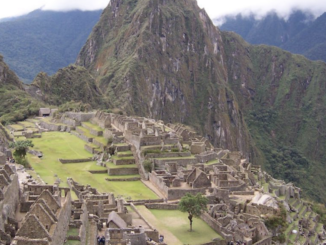More writings by uncle, John Alldridge. This time he is reporting from South America in 1960 for the Birmingham Evening Mail – Jerry F
The country where strangers get drunk on fresh air and where revolutions are almost a national sport
“Now take it easy!” warned the pretty Panagra stewardess as I prepared to land on Bolivian soil.
Sixty seconds later I saw what she meant.
I was wheezing like an old man, trying to walk on rubber legs to an airport building that seemed an impossible distance away…
This was my introduction to La Paz, the highest capital in the world. It was also my first experience of mountain sickness: a curious complaint which affects most visitors when they find themselves trying to behave normally at a height of 13,000 feet.
Until you become acclimatised you feel as if you are drowsily drunk. Your reactions are slow; you move at half-speed, mentally and physically. The simple business of walking upstairs sets your heart pounding madly.
The effect on me was so violent and so unexpected that I am not at all clear what actually happened in the next half-hour. I seem to remember being whisked away in a taxi and shuddering as we swung round a bend and I saw La Paz hanging on like grim death — or so it seemed to me — to the sides of a canyon a thousand feet below.
It has been hanging on like that, ready to fall into space any minute, since October 20, 1548, when the Spaniards founded it, probably to escape the freezing winds that blow across this bleak, treeless plateau.
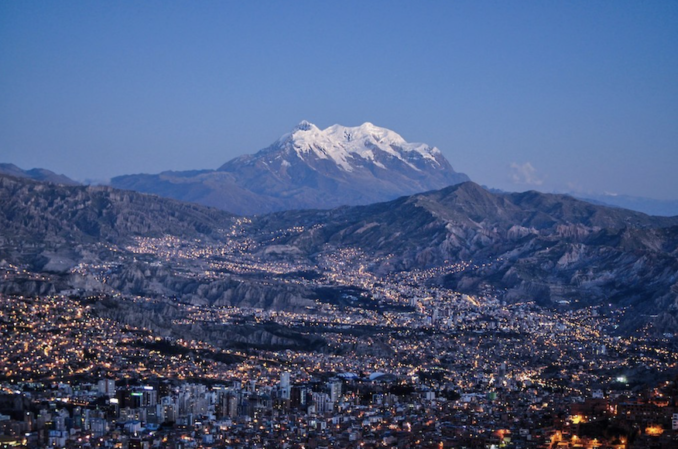
View of La Paz from El Alto,
EEJCC – Licence CC BY-SA 4.0
It now shelters a population of 335,000, about half of them Indians. They don’t appear to mind living in a city where everything is going either upstairs or down.
Nothing in La Paz seems to be on the flat. To appreciate it properly you should be a mountain goat.
Coping with the altitude is one of the major problems of life in La Paz. At this height a motor car engine wears out in a matter of months. You can’t soft-boil potatoes. Bread goes stale almost as soon as it is baked. There is one advantage. Because of the
small amount of oxygen in the air, the city can do without a fire brigade.
At this height, too, tempers fray very quickly. Life swings violently from a state of physical numbness to one of intense nervous irritability. Nothing is so unpredictable, they say, as a Bolivian.
It probably explains why a city whose name means Peace has had such a singularly violent history.
In Bolivia revolutions are almost a national sport. They have had 179 of them in the past 130 years. At one time the country had three different presidents in the same day.
Some of these presidents have been very curious characters. There was a 19th-century dictator called Melgarejo, a rough-and-ready type, who invited the diplomatic corps to a reception given in honour of his latest mistress.
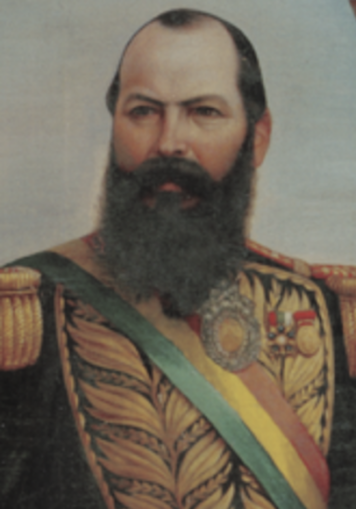
Mariano Melgarejo,
luisarielvega – Public domain
The British Ambassador, rather stuffily, declined.
Melgarejo showed his displeasure by having the unfortunate ambassador arrested, stripped naked, and driven through La Paz on the back of a donkey.
When Queen Victoria heard about this she was so furious that she ordered Bolivia to be erased from all British maps and charts. Whereupon Melgarejo, not a whit perturbed, had Great Britain removed from his maps. And so the matter stood for several years.
Another more recent president committed suicide by drinking himself to death. His successor was beaten up and driven out of town by his friends when he proposed to introduce constitutional elections.
I followed the Panagra Airline advice and took a taxi down to the Plaza Murillo and ambled gently around the city’s hub.
I stared fascinated up at the balcony of the Presidential Palace. The stonework is pockmarked with bullet holes: proof of the lusty way in which Bolivians enjoy their politics.
Down in the square stands a very ordinary lamppost. A single pillar sprouting three globes. That is probably the most famous lamppost in South America. In July, 1947, they hanged President Villaroel from it.
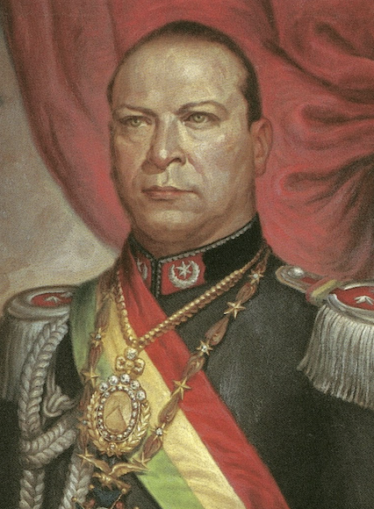
Retrato de Gualberto Villarroel López,
Cuadro de Luis Walpher (1954) – Licence CC BY-SA 4.0
Now a memorial tablet tastefully decorated with flowers, marks the spot. Two sombre, shabbily-dressed, sentries stand on permanent guard. Nothing so unpredictable as a Bolivian.
My first reaction to La Paz was to wonder why anyone should choose to live up here on the roof of the world; a bare, windswept plateau set about with mountains, upon which practically nothing grows.
There are plenty of lush, tropical valleys in the country where life could be much more bearable. In fact about 70 per cent of Bolivia is in the tropics. And yet 75 per cent of Bolivians insist obstinately on being huddled up here in this harsh Altiplano.
I soon discovered there are two very good reasons.
In the first place Bolivia’s fortunes have always depended on its mineral wealth of silver and tin. And these treasures are buried high up in the Altiplano.
In the second, seven Bolivians out of ten are Indians. And their spiritual home is in the highlands, where their ancestors lie buried on the hilltops, and where they follow a way of life passed on to them by their forbears, the Incas, which even today remains almost intact.
The capital of the Inca Empire
I took a taxi out along the 30 miles of winding, dusty road to Lake Titicaca, that strange, mysterious stretch of water from whence, the Incas believed, life began.
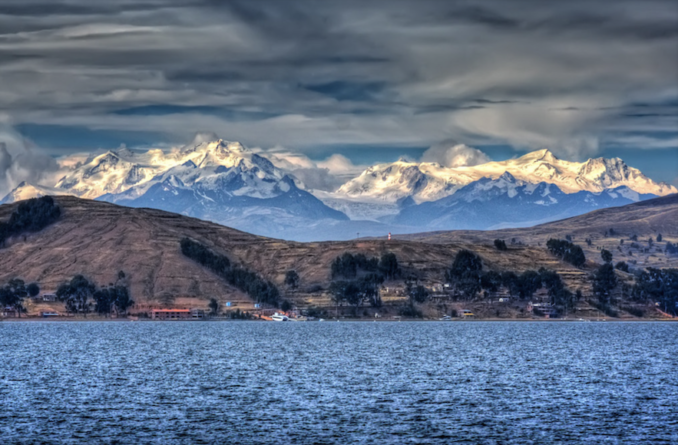
View of lake Titicaca from the Isla del Sol,
Pedro Szekely – Licence CC BY-SA 2.0
This is Indian country. And a marvellously picturesque sight they make, these Indian women in their gay shawls and many petticoats—which they never, never take off under any circumstances, their hard brown bowler hats pressed down squarely on their black-braided hair.

Women and children around the Cathedral. La Paz,
Dennis Jarvis – Licence CC BY-SA 2.0
They jog-trot across country at a speed that made me dizzy just to look at them, jiggling a papoose on their backs and spinning as they go, from a wool ball on a distaff, in a manner that was old when Troy was young.
They raise just enough maize and potatoes to live on. To keep their spirits up they chew the leaves of the coca tree. And without the llama they would die.
Like his cousin, the camel, the llama is all-providing. He furnishes the Indian with food, wool, transport, and fuel. Like the camel, too, he is a temperamental beast. He will carry loads of up to a hundred pounds. But just try loading one extra pound above that and he will spit in your eye. But the Indian knows how to handle the llama; he spits right back…
The Spaniards found the silver. The Indians dug it out for them and died like flies of silicosis. In 1554 they discovered their Cerro Rico, the Silver Mountain, and founded the town of Potosi at its foot.
Twenty thousand million silver coins were struck here and sent home to Spain. Their huge mint still stands in the centre of the town.
By the middle of last century the best of the silver had been mined. But by then another metal more precious even than silver had come into its own — tin.
When you talk of tin in La Paz you are really thinking of Simon Patino, the man they called the Tin King.
He was three-quarters Indian and ran mule and llama teams into the hills. He was doing nicely when he was saddled with a bad debt.
Another local businessman couldn’t settle his bill. He gave Patino an interest in his tin mine instead.
And there began the fabulous Patino fortune. He worked the mine himself, night and day. Gradually he began to buy up other mines. Within fifteen years he controlled 70 per cent of Bolivia’s tin production.
By the end of World War I he was Tin King of the World, his wealth estimated — for Simon never gave details of his fortune — at £100,000,000.
He left La Paz in 1922 and never returned. The altitude affected his health, he said. He settled in Paris and married his son and daughters off to a Spanish princess and French counts.
For 30 years, from a distance of 5,000 miles, Simon Patino was the real ruler of Bolivia.
Then in 1952 came another revolution. And the most important of all. A new Left Wing Government came in and promised sweeping reforms. There would be equal votes for all.
The big estates would be broken up and the land shared out among the small tenant farmers. And the tin mines would be nationalised.
On the last day of October, 1952, Patino Mines became the Mining Company of Bolivia. The Patino family is still waiting for compensation…
But nothing ever seems to go right for poor, unhappy, unpredictable Bolivia. When the jubilant Government experts began to examine the Patino mines they found to their dismay that the rich seams were almost worked out.
A young Scots mining engineer assured me there are still plenty of other metals waiting to be exploited. But the Indian miner, now tightly organised, is demanding a rate of pay which makes the whole thing uneconomic.
As for the Indian farmer, he is a landowner now. But he goes on his own immemorial way: growing just enough to feed his family, and spending what little he earns on drinking sessions that sometimes last a week.
Meanwhile, in La Paz, inflation spirals sky-high. Without the economic aid it receives in such generous measure from the United States, Bolivia would topple over into total bankruptcy. And from there into the waiting arms of the Communists.
As I drove up the steep zig-zag path back again to the highest airport in the world, I heard a succession of loud reports coming up from below.
Of course, it could have been an engine backfiring…
Reproduced with permission
© 2023 Newspapers.com
Jerry F 2023



